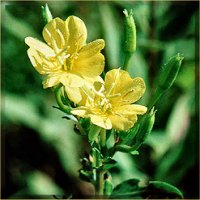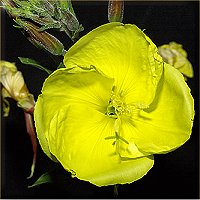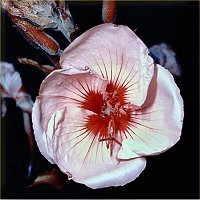
Oenothera biennis

Oenothera biennis
Common Names - Echte Nachtkerze, EPO, fever plant, gamma-linolenic acid (GLA), herbe aux anes, Huile D'Onagre, kaempe natlys, king's cureall, la belle de nuit, nachtkerzenol, night willow-herb, Oenothera communis Leveill, Oenothera graveolens Gilib, omega-6 essential fatty acid, Onagra biennis Scop, Onogra vulgaris , onagre bisannuelle
Genus - Oenothera
Description - Biennial or perennial 1 to 2 inch pale yellow flower has four petals atop the long, slender calyx tube; flowers open in the evening and remain open through morning, closing in the heat of the day Spring to fall. The leaves are eclliptic to lance-shaped and stems are 1 to 6 inches long, wavy-toothed; erect, stout and often red-tinged
Evening primrose has served as both food and medicine at previous times throughout history, often for upset stomach and respiratory infections. Native Americans ate the boiled, nutty-flavored root, and used leaf poultices from the plant for bruises and hemorrhoids. European settlers took the root back to England and Germany, where it was introduced as food and became known as German rampion because it grew as a crawling vine. The plant was also a Shaker medicine, sold commercially. The Flower also has a unique identifying marker - the flower unmistably stands out under ultraviolet-light!


Standard
Light
Ultra-violet light
Edible Uses - Flowers; Leaves; Oil; Root; Seedpod.
Pharmacology - Evening Primrose Oil is roughly 14% of the seed, 50 to 70% cis-linoleic acid, 7 to 10% cis-gamma-linolenic acid (GLA), plus cis-6,9,12-octadecatrienoic acid, oleic, palmitic and steric acids, campesterol and beta-sitosterol steroids. The seed is very small and difficult to harvest, it has to be done by hand. Overall yields are low, making the oil very expensive to produce.
Medicinal Uses - Anticholesterolemic; Astringent; Hypotensive; Miscellany; Sedative.
Regular consumption of the oil helps to reduce blood cholesterol levels and lower the blood pressure.
Flowers:
Root:
Traditional Uses - Alcoholism, antioxidant, atherosclerosis, bruises (primrose oil applied to the skin), chemotherapy-induced neuropathy (nerve damage), Crohn's disease, cystic fibrosis, diabetes, disorders of the stomach and intestines, fibroadenomas, hangover remedy, heart disease, hepatitis B, high cholesterol, hot flashes, inflammation, irritable bowel syndrome, kidney stones, melanoma, multiple sclerosis, pain, post-menopausal symptoms, post- natal depression, preventing preterm delivery, promoting easier birth, Sj;ouml;gren's syndrome, skin conditions due to kidney failure in dialysis patients, systemic lupus erythematosus (SLE), ulcerative colitis, weight loss, whooping cough, wound healing (primrose oil poultice applied to the skin).
Contra-indications - Evening primrose oil, and by extension GLA, should not be consumed by schizophrenic patients taking phenothiazine medications such as Compazine (prochlorperazine), Mellaril (thioridazine), Sparine (promazine), Stelazine (trifluoperazine), Thorazine (chlorpromazine), or Trilafon (perphenazine). The combination may increase the risk of epileptic seizure. Other medications, such as Wellbutrin and other antidepressants, may also lower the seizure threshold and thus might interact with evening primrose oil.